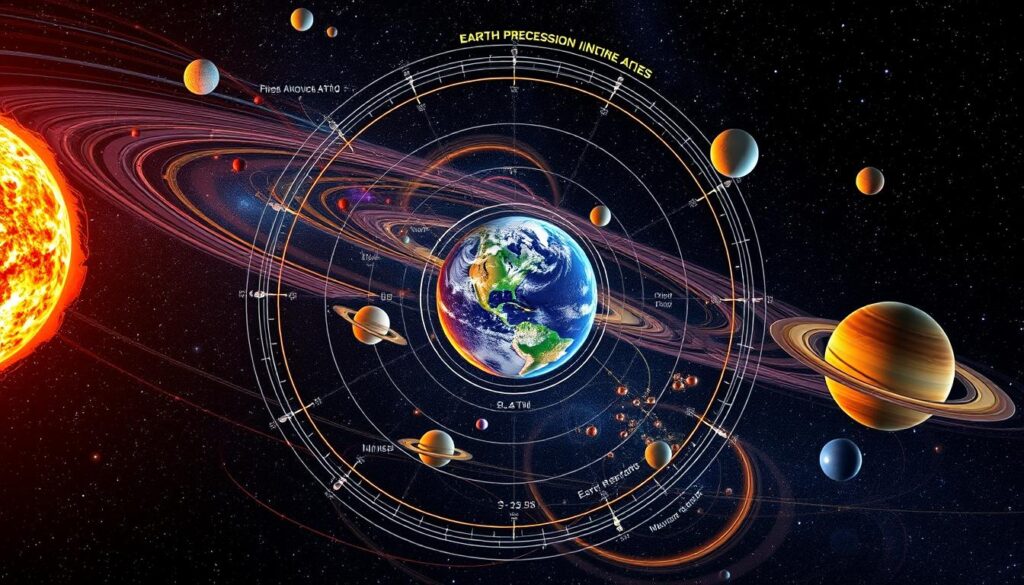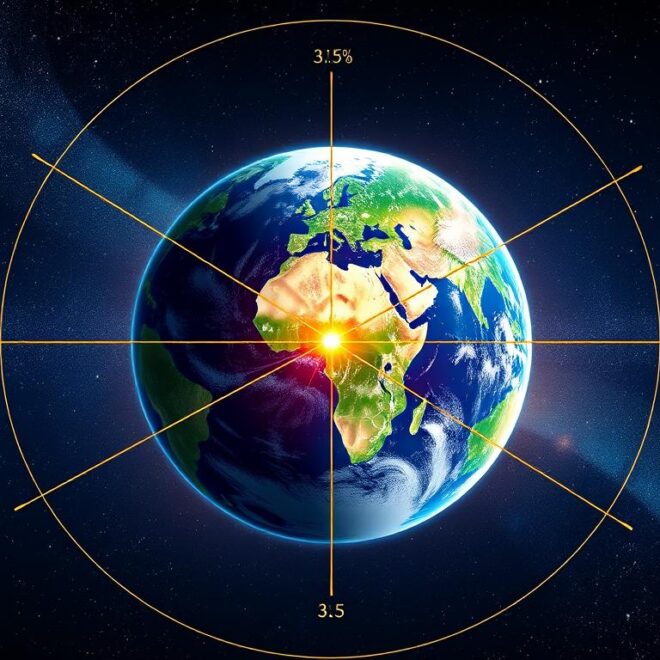Recent studies have shown a surprising change in Earth’s tilt. Our planet has tilted by 31.5 inches (80 centimeters) in the last 100 years. This change, called the “obliquity of the ecliptic,” is due to the complex ways our planet moves in the solar system. Knowing about this tilt is important because it affects our climate, weather, and even GPS systems.
The Earth’s tilt, or obliquity, is the angle between its orbit and equator. This tilt, currently 23.44 degrees, causes the seasons and affects how sunlight spreads around the world. But this angle changes over time, something scientists have watched and recorded for centuries.
Key Takeaways
- The Earth’s axis has shifted by 31.5 inches (80 centimeters) over the past century.
- This change in the Earth’s obliquity, or axial tilt, is the result of complex celestial mechanics.
- The Earth’s axial tilt influences the planet’s seasons, climate, and weather patterns.
- The shift in the Earth’s orientation can impact the accuracy of global positioning systems.
- Understanding the causes and implications of this axial shift is important for scientists and policymakers.
Understanding Earth’s Recent Axial Shift
Earth’s axis, the line around which our planet spins, is always moving. This is because of a process called axial precession. It happens because Earth is tilted 23.5 degrees from its orbit plane around the sun. This shift, part of the Milankovitch cycles, takes about 26,000 years.
Measuring Changes in Earth’s Orientation
It’s hard to track these small changes in Earth’s spin. Scientists use special methods like satellite images and laser ranging. They also use radio interferometry to spot tiny changes in Earth’s tilt and spin.
Impact on Global Positioning Systems
These changes affect GPS systems, which use satellites for location data. As Earth’s axis moves, GPS satellites must adjust their spots to stay accurate. This is key for GPS to work well in things like navigation and science.
Scientific Methods of Detection
Scientists use many ways to find out about Earth’s tilt changes. They use Very Long Baseline Interferometry (VLBI), Satellite Laser Ranging (SLR), and Global Navigation Satellite Systems (GNSS). These tools help them track the earth tilted 23.5 degrees very precisely. This gives them important info about Earth’s long-term spin.
Earth Tilted 31.5 Inches: Recent Observations and Data
Scientists and the public are talking about the Earth’s tilt. Our planet has tilted by 31.5 inches. This is a big change from its usual tilt.
Experts in celestial mechanics have been studying this change. They use advanced tools to track and measure the tilt. This gives us important information about why it happened and what it means.
“The shift in the Earth’s tilt is a profound event, one that has the earth’s axial tilt impact various aspects of our planet’s climate and environmental systems,” explains Dr. Samantha Grayson, a renowned astrophysicist at the University of California, Berkeley.
The data shows that gravity is behind this tilt. This is part of celestial mechanics. The Earth’s orbit and other planets in our solar system also play a role.

The scientific community is studying this tilt closely. It’s clear that the 31.5-inch tilt is a big deal. We need to keep watching and learning more about it.
The Relationship Between Earth’s Axial Tilt and Climate
Earth’s axial tilt, or obliquity of the ecliptic, is key to our climate. It’s currently at 23.44 degrees. This tilt shapes our seasons, solstices, and equinoxes. Knowing how tilt affects climate helps us prepare for changes.
Effects on Weather Patterns
The Earth’s tilt changes how sunlight spreads around the world. This leads to different temperatures and weather. As the tilt changes, some areas get more sunlight, while others get less. This affects the strength of seasons and the occurrence of extreme weather.
Long-term Climate Implications
Over time, changes in Earth’s tilt can greatly impact our climate. Milankovitch cycles describe these changes. They help explain ice age cycles and other long-term climate shifts.
Regional Impact Assessment
The effects of Earth’s tilt vary by region. Some areas see big changes in seasons and weather. It’s important to understand these regional impacts to help communities adapt and stay resilient.

“Understanding the delicate balance between Earth’s tilt and our climate is essential for anticipating and mitigating the challenges we may face in the years to come.”
Natural Causes Behind Earth’s Shifting Axis
Earth’s axis shifts due to natural forces. Two main factors are at play: axial precession and Milankovitch cycles.
Axial precession is when Earth’s axis slowly changes direction. It takes about 26,000 years for a full cycle. This happens because the Sun and Moon’s gravity affects Earth’s equatorial bulge.
Milankovitch cycles involve changes in Earth’s orbit and tilt. These changes happen over 20,000 to 100,000 years. They are caused by Earth’s orbit shape changes and axis tilt fluctuations.
The mix of axial precession and Milankovitch cycles leads to Earth’s slow orientation shifts. These shifts can cause big climate changes over long periods.
| Phenomenon | Description | Cycle Duration |
|---|---|---|
| Axial Precession | Gradual shift in Earth’s axis of rotation | 26,000 years |
| Milankovitch Cycles | Variations in Earth’s orbit and axial tilt | 20,000 to 100,000 years |
These natural forces, driven by gravity, are key to Earth’s axis shifts. They also lead to climate changes over long times.

Comparing Historical Axial Changes
Earth’s tilt, or obliquity of the ecliptic, has changed over time. The tilt of 23.5 degrees has been steady for thousands of years. But, it hasn’t always been this way. Looking at scientific records shows interesting patterns in Earth’s tilt changes.
Notable Shifts Throughout Earth’s History
The recent 31.5-inch tilt is big, but it’s not the biggest. In the past, Earth’s tilt has changed a lot. For example, 300 million years ago, it was about 27 degrees. And 100 million years ago, it was as low as 22 degrees.
Patterns in Axial Movement
Studies show Earth’s tilt goes between 22.1 and 24.5 degrees every 41,000 years. This change is thought to be caused by other planets’ gravity and Earth’s own movements.
Scientific Record Analysis
Scientists have pieced together Earth’s tilt history using geological and astronomical data. They found Earth’s tilt has mostly stayed the same, with small changes. This stability has helped make Earth a place where life can thrive.





